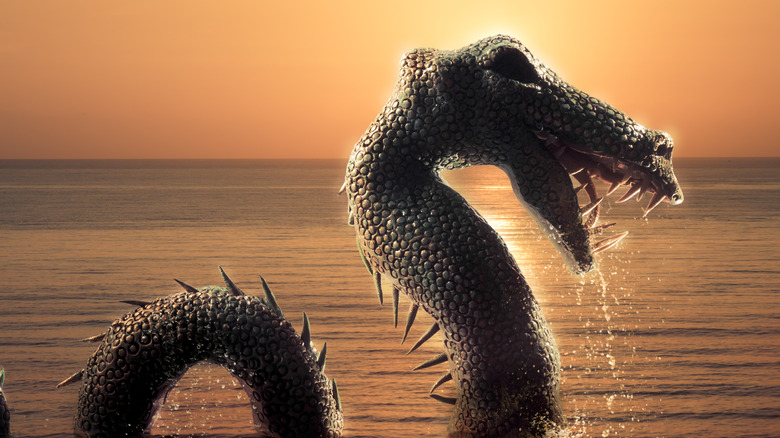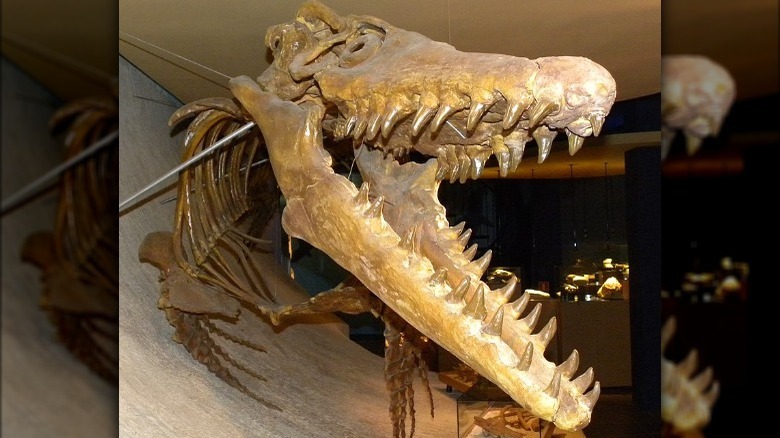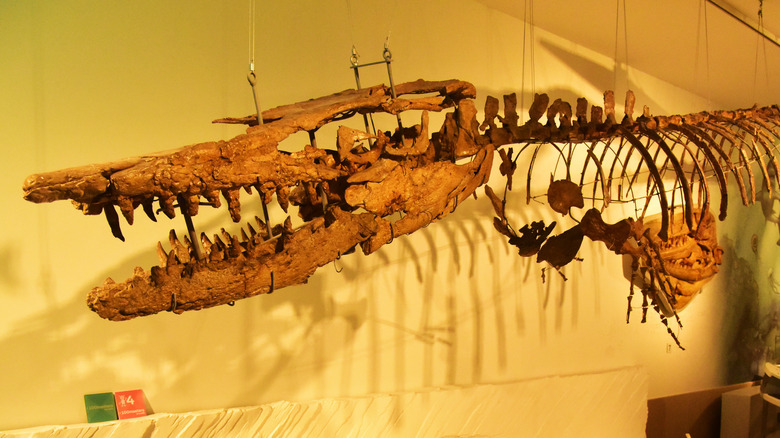This 40-Foot-Long Sea Creature's Fossils Prove Your Favorite Monster Movies May Not Be Far Off
The ocean is a vast, treacherous, and beautiful place. According to the National Ocean Service, most experts believe that 91% of species that reside within the confines of the deep blue have yet to be classified and that more that 80% of our oceans remain "unmapped, unobserved, and unexplored." It's tough to say how long it will take us to fully understand and interpret the size and scope of the ocean's primal magnitude — or if we ever will — but as we continue to probe the depths of our seemingly depthless seas, we discover things that baffle us nearly beyond comprehension.
Live Science reports that researchers discovered something devastating and magnificent off the coast of Morocco in August of 2022. Skeletal fragments of what was once a Thalassotitan atrox ("T. atrox") were found, including parts of its skull, jaws, teeth, and spine. The mangled bones of other ocean-dwelling beings it was known to prey upon were also uncovered nearby.
Thalassotitan atrox, a real life monster
The Thalassotitan atrox, otherwise known as a mosasaur, was an oceanic predator that existed near the end of the Cretaceous era some 66 million years ago, as Live Science reports. The 40-foot monster of the deep is reputed to have been one of the most aggressive and violent beasts to ever exist, regularly devouring anything in its path and subsisting on whatever it could find. The mosasaur was indiscriminate toward what it considered food and is believed to have even cannibalized members of its own species at times.
"Thalassotitan was an amazing, terrifying animal," said Dr. Nick Longrich, senior lecturer at the University of Bath and the expert who led the study. "Imagine a komodo dragon crossed with a great white shark crossed with a T. rex crossed with a killer whale." Read that again. It almost sounds like some cruel little fable cooked up by mean kids who want to scare their younger siblings before bed, but it's not. The mosasaur was a harrowing monster that actually prowled the ocean at one point in time, and you can bet that if it were still around today, great white sharks and killer whales would be the least of your concerns on a scuba diving trip (via Newsweek).
What happened to the terrifying mosasaur?
According to Live Science, "Thalassotitan" is Greek for "sea giant," and "atrox" in Greek means "cruel." If it weren't already obvious, the mosasaur definitely lived up to its namesake. The fossils discovered in August of this year off the coast of Morocco contained teeth that had been worn down, chipped, or broken off entirely. The mosasaur resorted to especially violent and ravenous attack methods by means of subduing its prey and oftentimes damaged its teeth in the midst of the frenzied assaults.
While dinosaurs held sway over all land-dwelling beasts, mosasaurs — which actually bore direct familial ties to lizards and snakes – reigned among the most fearsome and lethal kings to ever rule the oceans. However, like their soil-stomping counterparts, the magnificent mosasaurs tragically went extinct after an asteroid struck the earth tens of millions of years ago. "They were wiped out by the asteroid impact, just like the dinosaurs," Dr. Longrich went on in his interview with Newsweek. "They seem to have been active, even warm-blooded animals, and this and their large size meant they needed a lot of food. When the debris from the asteroid blocked out the sun, photosynthesis shut down, plankton stopped growing, and the food chain just sort of fell apart."


